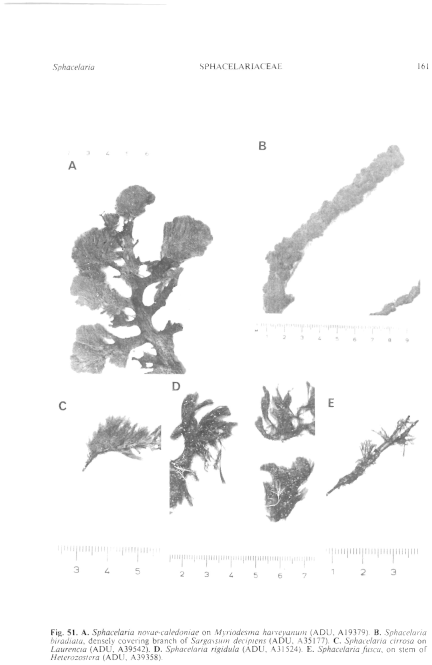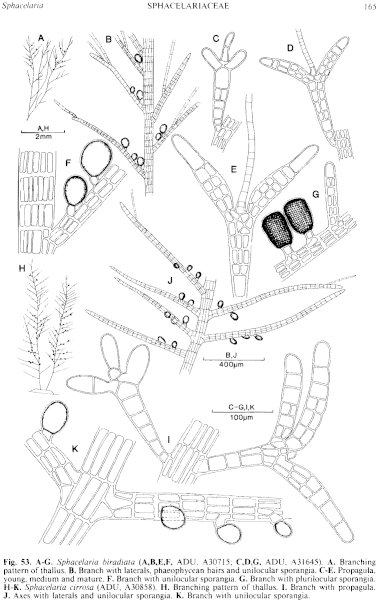|
|
|
|
|
|||||||||||
|
Electronic Flora of South Australia Species Fact Sheet
Phylum Phaeophyta – Order Sphacelariales – Family Sphacelariaceae
Selected citations: Prud'homme van Reine 1982: 225, figs 565–646, pl. 6. Sauvageau 1902: 415 (R227), figs 44–46. Womersley 1967: 199.
Thallus (Figs 51C, 53H) olive to dark brown, (0.2–) 0.5–3 cm long, forming loose to dense tufts, epiphytic on various algae and seagrasses, arising from a basal cell plate or stoloniferous, occasionally with descending rhizoids from lower erect axes. Branching (Fig. 53H,J) of the well developed, erect, axes abundant, with more or less determinate, evenly tapering laterals arising every few segments, subdistichously to more usually radially arranged, alternate to occasionally opposite, usually at wide angles to the axes and with the laterals narrower than the axes; phaeophycean hairs usually abundant, especially near tips of laterals, 10–15 µm in diameter. Axes (Fig. 53J,K) 40–70 (–80) µm in diameter with segments L/B (0.7–) 1.0–1.3 (–1.5) and showing 3–4 (–8) longitudinal walls; laterals (Fig. 53J,K) (20–) 30–50 µm in diameter with segments L/B 0.8–1.2 (–1.5) and showing 1–3 longitudinal walls; secondary transverse walls absent except in cells from which laterals arise.
Reproduction: Propagula (Fig. 531) with 3 (–4) arms formed successively but soon becoming of equal length, each arm basally constricted and tapering above, 120–200 (–350) µm long and 15–35 µm in maximum diameter, borne on a pedicel (100–) 120–160 (–200) µm long, and with the apical cell usually developing into a hair but sometimes remaining as an umbonate cell. Unilocular sporangia (Fig. 53J,K) often profuse, adaxial or scattered, single or opposite, shortly pedicellate, ovoid, (45–) 50–65 (–100) µm long and 40–50 µm in diameter. Sexual plants (Prud'homme van Reine 1982, p. 232) with either plurilocular macrogametangia usually 55–85 µm long and 40–65 µm in diameter, or microgametangia usually 65–100 µm long and 35–60 µm in diameter; plurilocular sporangia may also occur. (Plurilocular organs not recorded for Australian plants.)
Lectotype from Trieste, Italy (Wulfen); neotype in WU.
Selected specimens: Fremantle, W. Aust. (Harvey, Alg. Aust. Exsicc. 106A, in NSW). Nanarup (32 km E. of Albany), W. Aust., on Cladostephus, upper sublittoral (Gordon, I 9.xi.1968; ADU, A33983). Off Troubridge Light, Edithburgh, S. Aust., on Dictyopteris muelleri, 18 m deep (Shepherd, 4.ii.1969; ADU, A33552). Aldinga, S. Aust., on Clystophora monilifera, drift (Womersley, 25.iv.1966; ADU, A30268). Vivonne Bay, Kangaroo I., S. Aust., on Griffithsia teges in large pool, shaded (Womersley, 29.x.1966; ADU, A30858, with unilocular sporangia). Cape Nelson, Vic., on Laurencia, mid eulittoral pool (Womersley, 2.ix.1971; ADU, A39542, with unilocular sporangia). Apollo Bay, Vic., in lower eulittoral pools on Point Bunbury (Womersley, 13.x.1985; ADU, A56908 (epilithic) and ADU, A56909 (on Cladostephus)-"Marine Algae of southern Australia" No. 257 and 257a resp.)
Distribution: Widespread in temperate and subtropical seas.
In southern Australia, from Fremantle, W. Aust. to Port Jackson, N.S.W.
Taxonomic notes: Sphacelaria cirrosa differs from S. biradiata in having more strongly developed axes bearing more profuse, determinate laterals, in the 3-armed propagula with the arms arising successively (but usually very soon becoming equal), and in the unilocular sporangia being ovoid rather than spherical.
S. cirrosa is less common than S. biradiata but usually is larger and occurs in pools or calmer habitats; it varies considerably in robustness in different habitats.
References:
GOODBAND, S.J. (1971). The taxonomy of Sphacelaria cirrosa (Roth) Ag., Sphacelaria fusca (Huds.) Ag., and Sphacelaria furcigera (Kuetz.) Sauv. A simple statistical approach. Ann. Bot. 35, 957–980.
PRUD'HOMME VAN REINE, W.F. (1982). A taxonomic revision of the European Sphacelariaceae (Sphacelariales, Phaeophyceae). Leiden Botanical Series, Vol. 6. (Brill: Leiden.)
WOMERSLEY, H.B.S. (1967). A critical survey of the marine algae of southern Australia. II. Phaeophyta. Aust. J. Bot. 15, 189–270.
The Marine Benthic Flora of Southern Australia Part II complete list of references.
Publication:
Womersley, H.B.S. (14 December, 1987)
The Marine Benthic Flora of Southern Australia
Part II
©Board of the Botanic Gardens and State Herbarium, Government of South Australia
Illustrations in Womersley Part II, 1997: FIGS 51C, 53 H–K.

Figure 51 enlarge
Fig. 51. A. Sphacelaria novae-caledoniae on Myriodesma harveyanum (ADU, A19379). B. Sphacelaria biradiata, densely covering branch of Sargassum decipiens (ADU, A35177). C. Sphacelaria cirrosa on Laurencea (ADU, A39542). D. Sphacelaria rigidula (ADU, A31524). E. Sphacelaria fusca, on stem of lieterozostera (ADU, A39358).

Figure 53 enlarge
Fig. 53. A–G. Sphacelaria biradiata (A,B,E,F, ADU, A30715; C,D,G, ADU, A31645). A. Branching pattern of thallus. B. Branch with laterals, phaeophycean hairs and unilocular sporangia. C–E. Propagula, young, medium and mature. F. Branch with unilocular sporangia. G. Branch with plurilocular sporangia. H–K. Sphacelaria cirrosa (ADU, A30858). H. Branching pattern of thallus. I. Branch with propagula. J. Axes with laterals and unilocular sporangia. K. Branch with unilocular sporangia.

|
Email Contact: State Herbarium of South Australia |

|